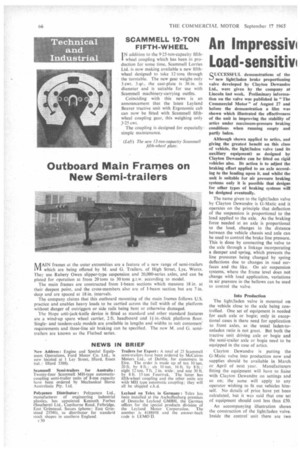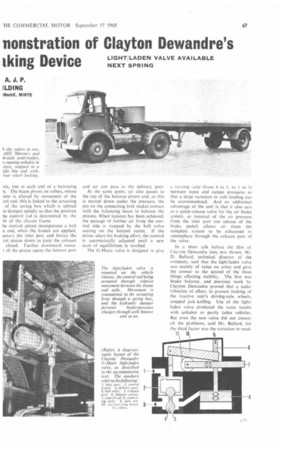An Impressivi Load-sensitiv nonstration of tking Device Clayton Dewandre's
Page 68

Page 69

If you've noticed an error in this article please click here to report it so we can fix it.
A. J. P. ILDING
I Mech E, M I RTE
QUCCESSFUL demonstrations of the 1,--/ new light/laden brake proportioning valve developed by Clayton Dewandre Ltd., were given by the company at Lincoln last week. Preliminary information on the valve was published in "The Commercial Motor" of August 27 and before the demonstration a film was shown which illustrated the effectiveness of the unit in improving the stability of artics under maximum-pressure braking conditions when running empty and partly laden.
Although shown applied to artics, and giving the greatest benefit on this class of vehicle, the light/laden valve (and its auxiliary equipment) as designed by Clayton Dewandre can be fined on rigid vehicles also. Its action is to adjust the braking effort applied to an axle according to the loading upon it, and whilst the unit is suitable for air pressure braking systems only it is possible that designs for other types of braking systems will be designed eventually.
The name given to the light/laden valve by Clayton Dewandre is G-Matic and it operates on the principle that deflection of the suspension is proportional to the load applied to the axle. As the braking force needed at an axle is proportional to the load, changes in the distance between the vehicle chassis and axle can be used to control the brake line pressure. This is done by connecting the valve to the axle through a linkage incorporating a damper and spring, which prevents the line pressures being changed by spring deflections due to changes in road surfaces and the like. On air suspension systems, where the frame level does not change with load application, variations in air pressure in the bellows can be used to control the valve.
Into Production The light/laden valve is mounted on the vehicle close to the axle being controlled. One set of equipment is needed for each aide or bogie; only in exceptional cases is there need for application to front axles, as the usual laden-tounladen ratio is not great. But both the tractive unit driving axle or bogie and the semi-trailer axle or bogie need to be equipped in the case of artics.
Clayton Dewandre is putting the G-Matic valve into production now and supplies should be available in March or April of next year. Manufacturers fitting the equipment will have to liaise with Clayton Dewandre on settings and so on; the same will apply to any operator wishing to fit out vehicles himself. No details of price have yet been calculated, but it was said that one set of equipment should cost less than £50,
An accompanying illustration shows the construction of the light/laden valve. Inside the control unit there are two
)ns, one at each end of a balancing n. The beam pivots on rollers, whose lion is altered by movement of the rol rod; this is linked to the actuating of the spring box which is splined le damper spindle so that the position he control rod is determined by he ht of the chassis frame.
he control piston incorporates a ball e and, when the brakes are applied, enters the inlet port and forces the rol piston down to keep the exhaust closed. Further downward moveof the piston opens the bottom port and air can pass to the delivery port.
At the same point, air also passes to the top of the balance piston and, as this is moved down under the pressure, the pin on the connecting fork makes contact with the balancing beam to balance the pistons. When balance has been achieved, the passage of further air from the control side is stopped by the full valve seating on the bottom outlet. If the driver alters his braking effort, the control is automatically adjusted until a new state of equilibrium is reached.
The G-Matic valve is designed to give
varyiniz ratio (from 4 to I, to I to I) between input and output pressures so that a large variation in axle loading can be accommodated. And an additional advantage of the unit is that it also acts as a quick-release valve for the air brake system, as removal of the air pressure from the inlet port (on. release of the brake pedal) allows air from the complete system to be exhausted to atmosphere through the exhaust port of the valve.
In a short talk before the film of Clayton Dewandre tests was shown, Mr. I). Ballard, technical director of the company, said that the light/laden valve was mainly of value on allies and gave the answer to the second of the three things affecting stability. Thc first was brake balance, and previous work by Clayton Dewandre proved that a redistribution of effort, to prevent locking of the tractive unit's driving-axle wheels, stopped jack-knifing. Use of the light! laden valve produced the sante results with unladen or partly laden vehicles. Rut even the new valve did not answer all the problems, said Mr. Ballard, for the third factor was the variation in road
11 10




















































































































































































